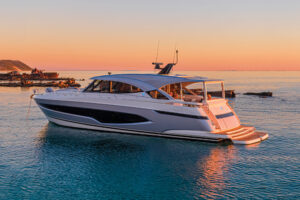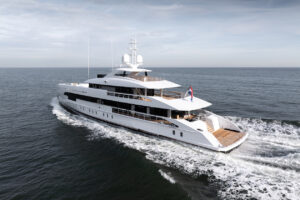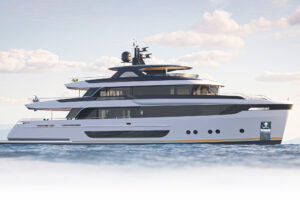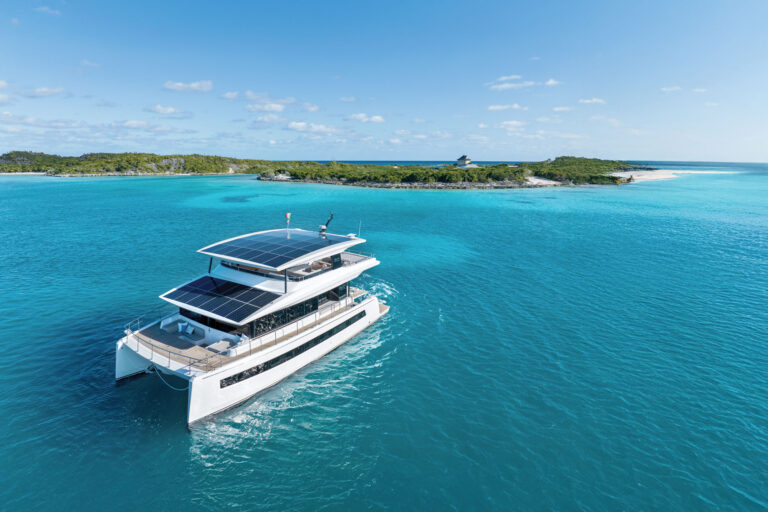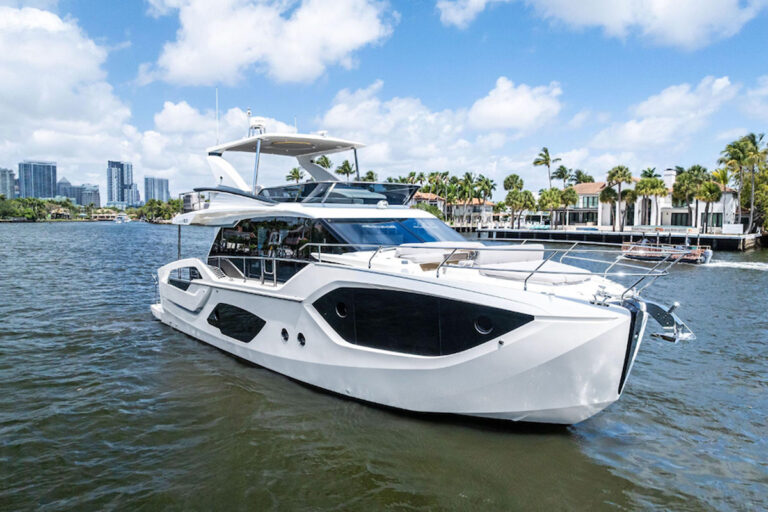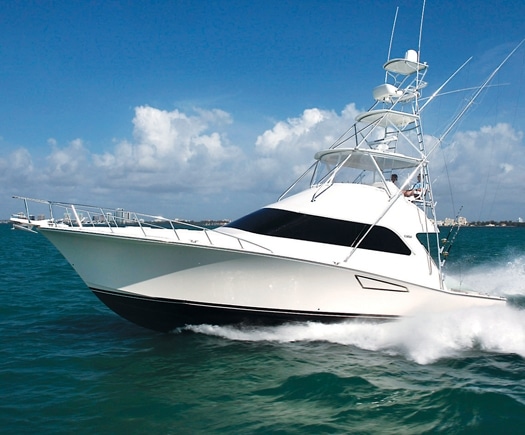
ytgaug09cabo52525.jpg
In trying economic times, corporations choose one of two reactions: Pull back on everything, especially R&D and marketing, or spend more money on both! From what I’ve seen in past recessions, companies who choose the latter course seem to emerge healthier, which in this case bodes well for Cabo Yachts.
The new 52 Flybridge is Cabo’s largest boat to date and its Michael Peters-designed hull found no challenge in the three- to four-foot seas outside Ft. Lauderdale’s inlet this past May. It ran smooth as silk in beam seas, and though we backed the throttles down from 32 knots to 26 when heading straight into the waves, the 52 still proved to be a terrific riding hull. Those of us who experienced the original Cabos will note that the head-sea capability of this new hull has come a very long way, and dryness has improved exponentially.
In the troughs, I managed a top speed of 41.5 knots at 2,325 rpm, burning 177 gph-that’s fast and not a speed you’ll be running too often offshore. A more realistic cruising speed of 27 knots proved the most economical, providing a range of 500 nautical miles, with a 73.5 gph consumption rate. If you wanted to drop your speed back to displacement levels, you could make passage to Bermuda strictly on integral fuel capacity.
The Cabo 52 responds to wheel input instantly for small course changes but scribes a fairly wide arc for 180-degree turns. One thing I’d like to see changed, however, is the placement of the engine on/off switches from beneath the crossbars of the wheel to underneath the helm pod where they’d be less easily switched off by mistake.
You’re unlikely to experience a problem with maneuvering the 52, either fishing or around the docks. You can back down at 6 knots in total control and spin with or without rudder. And if you happen to take water into the cockpit, advancing the throttles forward empties it in an instant. Drifting beam-to the four-footers showed the Cabo 52 to have a fairly long roll moment but with gentle enough transitions that it didn’t feel awkward.
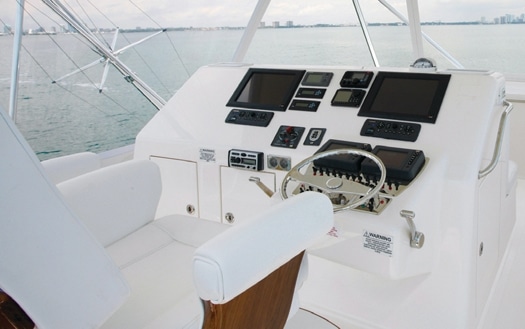
| | |
At 5 to 7 knots, the wake remained perfectly clear. Above that to about 15 knots, the tunnels channel subsurface turbulence, keeping it confined to two distinct lines. Outside these you get clear trolling alleys.
I’d hate to think of anyone taking enough fish to fill all the fishboxes aboard this 52. The 75-gallon transom livewell with Cabo’s signature aquarium window also doubles as a fishbox. Add to that the two huge in-deck boxes, and you could easily stow your limit.The “Tournament Package” Cabo 52 includes a PipeWelders tower and outriggers, Miya Epoch electric teaser reels over the helm, and a bait freezer in the cockpit mezzanine. And have no doubt-Cabos have a reputation for raising fish, so these extras won’t go unused.
If you’re the worrying sort, here’s a test you can perform to assuage your fears about the integrity of the gasketing and latches on the in-deck boxes aboard the Cabo 52: Open one of the huge fishbox hatches. Then let it slam shut. All hatches fit to such close tolerances that all you’ll hear is a whoosh. It wouldn’t wake an infant sleeping on the mezzanine seat.
Cabo offers tons of rod stowage aboard the 52. In addition to the open-air holders around the cockpit, the under-deck pantry in the galley also provides plenty of builtin rod-storage racks. You’ll find the most impressive rod repository, however, in the companionway belowdecks. A beautiful glass-door locker with architectural lighting, black-velvet lining, and handsome teak trim showcases your boat’s most striking fishing assets. High-quality tackle, after all, is art!
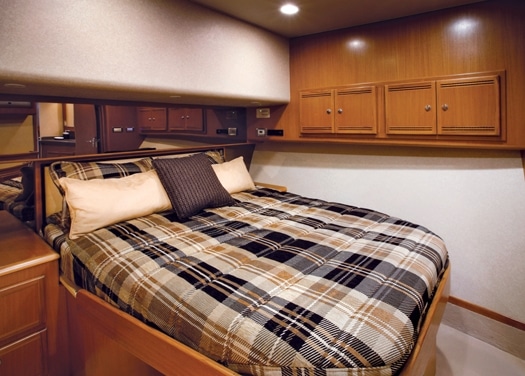
| | |
Comfortable accommodations may tempt the family to come along. The master stateroom is amidships with en suite head. To port is a stateroom with a single berth connected by a shared head to a forward double stateroom with plenty of stowage.
As you’d expect from a company with Cabo’s engineering reputation, the interior qualifies as luxurious without being ostentatious. I love the distinctive Cabo teak cabinetry with its renowned crosshatched ventilation strips that hide regular stowage, as well as additional rod storage on either side of the forward berth.
Other belowdecks appointments include Corian counters, a four-burner cooktop, and Sub-Zero refrigerator and freezer drawers, and they all draw power from unusually well-engineered wiring. Cabo distribution panels and engine compartments qualify as works of art in the engineering department.
The 52’s hull consists of ISO/NPG gelcoat, vinylester resins, and stitched biaxial fiberglass sandwiching Core-Cell-all vacuumbagged for a perfect laminate. The flybridge deck has end-grain balsa coring and polyester resins. The skeleton of the 52 boasts foam-cored fiberglass stringers combined with fiberglass web framing. And finally, marine-plywood bulkheads covered with satin-finish teak veneers provide the vertical structural support.
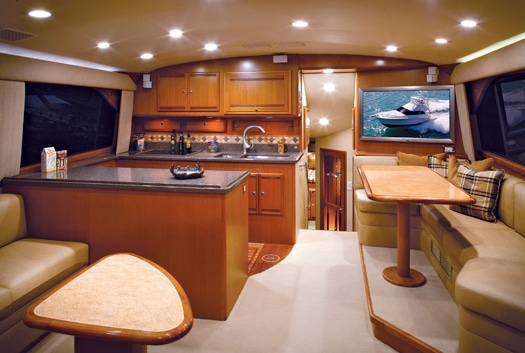
| | |
If you had any doubts about the continued high quality, innovation, or growth of Cabo Yachts in this global economic maelstrom, rest assured that the company couldn’t be in a better position for the turnaround. Overall, this 52 combines all the best performance features of recent Cabos into a roomier and more luxurious package.
Cabo Yachts, (760) 246-8917; **www.caboyachts.com**

